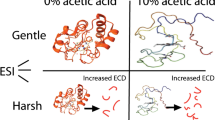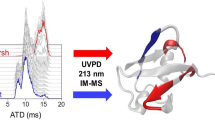Abstract
In most cases, kinetic unfolding reactions of proteins follow a simple one-step mechanism that does not involve any detectable intermediates. One example for a more complicated unfolding reaction is the acid-induced denaturation of holo-myoglobin (hMb). This reaction proceeds through a transient intermediate and can be described by a sequential two-step mechanism (Konermann et al. Biochemistry 1997, 36, 6448–6454). Time-resolved electrospray ionization mass spectrometry (ESI MS) is a new technique for monitoring the kinetics of protein folding and unfolding in solution. Different protein conformations can be distinguished by the different charge state distributions that they generate during ESI. At the same time this technique allows monitoring the loss or binding of noncovalent protein ligands. In this work, time-resolved ESI MS is used to study the dependence of the kinetic unfolding mechanism of hMb on the specific solvent conditions used in the experiment. It is shown that hMb unfolds through a short-lived intermediate only at acidic pH. Under basic conditions no intermediate is observed. These findings are confirmed by the results of optical stopped-flow absorption experiments. This appears to be the first time that a dependence of the kinetic mechanism for protein unfolding on external conditions such as pH has been observed.
Similar content being viewed by others
References
Anfinsen, C. B. Principles that govern the folding of protein chains. Science 1973, 181, 223–230.
Theorell, H.; Åkesson, A. Studies on cytochrome c. II. The optical properties of pure cytochrome c and some of its derivatives. J. Am. Chem. Soc. 1941, 63, 1812–1820.
Goto, Y.; Calciano, L. J.; Fink, A. Acid-induced folding of proteins. Proc. Natl. Acad. Sci. USA 1990, 87, 573–577.
Moore, G. R.; Pettigrew, G. W. Cytochromes c: Evolutionary, Structural and Physicochemical Aspects; Springer: Heidelberg, 1990.
Dunbar, J.; Yennawat, H. P.; Banerjee, S.; Luo, J.; Farber, G. K. The effect of denaturants on protein structure. Protein Sci. 1997, 6, 1727–1733.
Udgaonkar, J. B.; Baldwin, R. L. NMR evidence for an early framework intermediate on the folding pathway of ribonuclease A. Nature 1988, 335, 694–699.
Roder, H.; Elöve, G. A.; Englander, S. W. Structural characterization of folding intermediates in cytochrome c by H-exchange labelling and proton NMR. Nature 1988, 335, 700–704.
Dill, K. A.; Chan, H. S. From Levinthal to pathways to funnels. Natl. Struct. Biol. 1998, 4, 10–19.
Creighton, T. E. Protein folding. Biochem. J. 1990, 270, 1–16.
Hughson, F. M.; Wright, P. E.; Baldwin, R. L. Structural characterisation of a partly folded apomyoglobin intermediate. Science 1990, 249, 1544–1548.
Miranker, A.; Robinson, C. V.; Radford, S. E.; Aplin, R.; Dobson, C. M. Detection of transient protein folding populations by mass spectrometry. Science 1993, 262, 896–900.
Tsui, V.; Garcia, C.; Cavagnero, S.; Siuzdak, G.; Dyson, H. J.; Wright, P. E. Quench-flow experiments combined with mass spectrometry show apomyoglobin folds through an obligatory intermediate. Protein Sci. 1999, 8, 45–49.
Kiefhaber, T.; Labhardt, A. M.; Baldwin, R. L. Direct NMR evidence for an intermediate preceding the rate-limiting step in the unfolding of ribonuclease A. Nature 1995, 375, 513–515.
Staniforth, R. A.; Bigotti, M. G.; Allocatelli, F. C. C.; Brunori, M. Unfolding of apomyoglobin from aplysia limacina: The effect of salst and pH on the cooperativity of folding. J. Mol. Biol. 1998, 275, 133–148.
Panick, G.; Malessa, R.; Winter, R. Differences between the pressure- and temperature-induced denaturation and aggregation of beta-lactoglobulin A, B, and AB monitored by FT-IR spectroscopy and small-angle X-ray scattering. Biochemistry 1999, 38, 6512–6519.
Sosnick, T. R.; Mayne, L.; Hiller, R.; Englander, S. W. The barriers in protein folding. Nature Struct. Biol. 1994, 1, 149–156.
Konermann, L.; Rosell, F. I.; Mauk, A. G.; Douglas, D. J. Acid-induced denaturation of myoglobin studied by time-resolved electrospray ionization mass spectrometry. Biochemistry 1997, 36, 6448–6454.
Konermann, L.; Collings, B. A.; Douglas, D. J. Cytochrome c folding kinetics studied by time-resolved electrospray ionization mass spectrometry. Biochemistry 1997, 36, 5554–5559.
Zechel, D. L.; Konermann, L.; Withers, S. G.; Douglas, D. J. Pre-steady state kinetic analysis of an enzymatic reaction monitored by time-resolved electrospray ionization mass spectrometry. Biochemistry 1998, 37, 7664–7669.
Chen, Y.-L.; Campbell, J. M.; Collings, B. A.; Konermann, L.; Douglas, D. J. Stability of a highly charged noncovalent complex in the gas phase: Holomyoglobin. Rapid Commun. Mass Spectrom. 1998, 12, 1003–1010.
Lee, V. W. S.; Chen, Y.-L.; Konermann, L. Reconstitution of acid-denatured holo-myoglobin studied by time-resolved electrospray ionization mass spectrometry. Anal. Chem. 1999, 71, 4154–4159.
Konermann, L. Monitoring reaction kinetics by continuous-flow methods: The effects of convection and molecular diffusion under laminar flow conditions. J. Phys. Chem. A 1999, 103, 7210–7216.
Chowdhury, S. K.; Katta, V.; Chait, B. T. Probing conformational changes in proteins by mass spectrometry. J. Am. Chem. Soc. 1990, 112, 9012–9013.
Katta, V.; Chait, B. T. Observation of the heme—globin complex in native myoglobin by electrospray-ionisation mass spectrometry. J. Am. Chem. Soc. 1991, 113, 8534–8535.
Loo, J. A.; Edmonds, C. G.; Udseh, H. R.; Smith, R. D. Effect of reducing disulfide-containing proteins on electrospray ionisation mass spectra. Anal. Chem. 1990, 62, 693–698.
Konermann, L.; Douglas, D. J. Equilibrium unfolding of proteins monitored by electrospray ionization mass spectrometry: Distinguishing two-state from multi-state transitions. Rapid Commun. Mass Spectrom. 1998, 12, 435–442.
Konermann, L.; Douglas, D. J. Acid-induced unfolding of cytochrome c at different methanol concentrations: Electrospray ionization mass spectrometry specifically monitors changes in the tertiary structure. Biochemistry 1997, 36, 12296–12302.
Wang, F.; Tang, X. Conformational heterogeneity and stability of apomyoglobin studied by hydrogen/deuterium exchange and electrospray ionization mass spectrometry. Biochemistry 1996, 35, 4069–4078.
Vis, H.; Heinemann, U.; Dobson, C. M.; Robinson, C. V. Detection of a monomeric intermediate associated with dimerization of protein Hu by mass spectrometry. J. Am. Chem. Soc. 1998, 120, 6427–6428.
Pan, X. M.; Sheng, X. R.; Zhou, J. M. Probing subtle acid-induced conformational changes of ribonuclease A by electrospray mass spectrometry. FEBS Lett. 1997, 402, 25–27.
Loo, J. A.; Loo, R. R. O.; Light, K. J.; Edmonds, C. G.; Smith, R. D. Multiply charged negative ions by electrospray ionization of polypeptides and proteins. Anal. Chem. 1992, 64, 81–88.
Veenstra, T. D.; Johnson, K. L.; Tomlinson, A. J.; Naylor, S.; Kumar, R. Determination of calcium-binding sites in rat brain calbindin D28 K by electrospray ionization mass spectrometry. Biochemistry 1997, 36, 3535–3542.
Veenstra, T. D.; Johnson, K. L.; Tomlinson, A. J.; Craig, T. A.; Kumar, R.; Naylor, S. Zinc-induced conformational changes in the DNA-binding domain of the vitamin D receptor determined by electrospray ionization mass spectrometry. J. Am. Soc. Mass. Spectrom. 1998, 9, 8–14.
Nemirovskiy, O. V.; Ramanathan, R.; Gross, M. L. Investigation of calcium-induced, noncovalent association of calmodulin with melittin by electrospray ionization mass spectrometry. J. Am. Soc. Mass Spectrom. 1997, 8, 809–812.
Hu, P.; Loo, J. A. Determining calcium-binding stoichiometry and cooperativity of parvalbumin and calmodulin by mass spectrometry. J. Mass Spectrom. 1995, 30, 1076–1082.
Trigo-Gonzalez, G.; Awang, G.; Racher, K.; Neden, K.; Borgford, T. Helix variants of troponin C with tailored calcium affinities. Biochemistry 1993, 32, 9826–9831.
Feng, R.; Konishi, Y. Stepwise refolding of acid-denatured myoglobin: Evidence from electrospray mass spectrometry. J. Am. Soc. Mass Spectrom. 1993, 4, 638–645.
Loo, J. A. Studying noncovalent protein complexes by electrospray ionization mass spectrometry. Mass Spectrom. Rev. 1997, 16, 1–23.
Evans, S. V.; Brayer, G. D. High-resolution study of the three-dimensional structure of horse heart metmyoglobin. J. Mol. Biol. 1990, 213, 885–897.
Konermann, L.; Douglas, D. J. Unfolding of proteins monitored by electrospray ionization mass spectrometry: A comparison of positive and negative ion modes. J. Am. Soc. Mass Spectrom. 1998, 9, 1248–1254.
Mansoori, B. A.; Volmer, D. A.; Boyd, R. K. ‘Wrong-way-round’ electrospray ionization of amino acids. Rapid Commun. Mass Spectrom. 1997, 11, 1120–1130.
Collings, B. A.; Douglas, D. J. Conformation of gas-phase myoglobin ions. J. Am. Chem. Soc. 1996, 118, 4488–4489.
Hargrove, M. S.; Olson, J. S. The stability of holomyoglobin is determined by heme affinity. Biochemistry 1996, 35, 11310–11318.
Shen, L. L.; Hermans, J. Kinetics of conformation change of sperm-whale myoglobin. I. Folding and unfolding of metmyoglobin following pH jump. Biochemistry 1972, 11, 1836–1841.
Beechem, J. M.; Ameloot, M.; Brand, L. Global and target analysis of complex decay phenomena. Anal. Instrum. 1985, 14, 379–402.
Le Blanc, J. C. Y.; Guevremont, R.; Siu, K. W. M. Electrospray mass spectrometry of some proteins and the aqueous solution acid/base equilibrium model in the negative ion detection mode. Int. J. Ion. Mass Spectrom. Ion Processes 1993, 125, 145–153.
Guevremont, R.; Siu, K. W. M.; Le Blanc, J. C. Y.; Berman, S. S. Are the electrospray mass spectra of proteins related to their aqueous solution chemistry? J. Am. Soc. Mass Spectrom. 1992, 3, 216–224.
Laidler, K. J.; Meiser, J. H. Physical Chemistry, 3rd ed.; Houghton Mifflin Company: Boston, 1999.
Sage, J. T.; Morikis, D.; Champion, P. M. Spectroscopic studies of myoglobin at low pH: Heme structure and ligation. Biochemistry 1991, 30, 1227–1237.
Brandts, J. F.; Brennan, M.; Lin, L. Unfolding and refolding occur much faster for a proline-free protein than for most proline-containing proteins. Proc. Natl. Acad. Sci. USA 1977, 74, 4178–4181.
Bychkova, V. E.; Dujsekina, A. E.; Klenin, S. I.; Tiktopulo, E. I.; Uversky, V. N.; Ptitsyn, O. B. Molten globule-like state of cytochrome c under conditions simulating those near the membrane surface. Biochemistry 1996, 35, 6058–6063.
La Mar, G. N.; Davis, N. L.; Parish, D. W.; Smith, K. M. Heme orientational disorder in reconstitute and native sperm whale myoglobin. J. Mol. Biol. 1983, 168, 887–896.
La Mar, G. N.; Toi, H.; Krishnamoorthi, R. Proton NMR investigation of the rate and mechanism of heme rotation in sperm whale myoglobin: Evidence for intramolecular reorientation about a heme twofold axis. J. Am. Chem. Soc. 1984, 106, 6395–6401.
Adams, P. A. The kinetics and mechanism of the recombination reaction between apomyoglobin and haemin. Biochem. J. 1976, 159, 371–376.
Adams, P. A. The kinetics of the recombination reaction between apomyoglobin and alkaline haematin. Biochem. J. 1977, 163, 153–158.
Hunter, C. H.; Mauk, A. G.; Douglas, D. J. Dissociation of heme from myoglobin and cytochrome b5: Comparison of behavior in solution and the gas phase. Biochemistry 1997, 36, 1018–1025.
Author information
Authors and Affiliations
Corresponding author
Rights and permissions
About this article
Cite this article
Sogbein, O.O., Simmons, D.A. & Konermann, L. Effects of pH on the kinetic reaction. J Am Soc Mass Spectrom 11, 312–319 (2000). https://doi.org/10.1016/S1044-0305(99)00149-X
Received:
Revised:
Accepted:
Issue Date:
DOI: https://doi.org/10.1016/S1044-0305(99)00149-X




